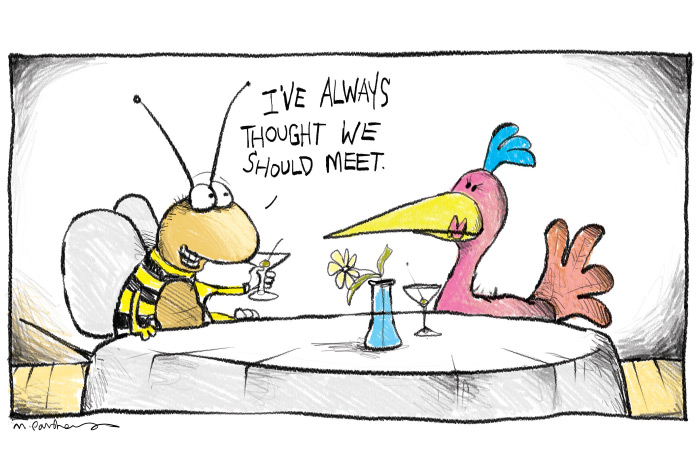The Incredible Shrinking Bumblebee Tongue

You may not have looked particularly closely at this, but when a bumblebee approaches a flower he goes right into the center of it, lowers himself down between all the brightly colored petals, looks down and then extends his tongue, swirls it into a straw, and extends it down into the bottom where the sweet nectar and pollen are. He then sucks up the nectar, swallows it and stores it in his special nectar stomach. He has two stomachs, one for the regular stuff he eats and the other for the nectar, and his throat can tell into which stomach the stuff coming down goes.
When finished, the bumblebee buzzes up and goes on to the next flower, where he gets more nectar. Eventually his second stomach is full so he has to go back to the hive to transfer the nectar to the worker bees, then he goes out and gets more. The worker bees chew on the nectar to make it rubbery, then they spit it into the honeycombs in the hive, and when that’s full they cover it up with wax. It’s stored there to get the hive through the winter.
This is really a neat thing. Almost makes you want to be a beekeeper, or anyway a scientist discovering the habits of the bees.
Well, here’s news. According to a study just published in the magazine Science, the tongues of a particular strain of bumblebee up in the mountains of Colorado are getting shorter and shorter as the years go by. This new study was done by Nicole Miller-Struttmann at SUNY Old Westbury, where she compared the lengths of the bumblebee tongues from years ago (from 1966 to 1980) with the length of bumblebee tongues she measured on recent forays out into Colorado between 2012 and 2014.
The reason the tongues are getting shorter, she has found, is that the bumblebees have long prized a particular flower with the nectar way down deep between the petals, very hard to get to. But now, with global warming, the flowers at that altitude are diminishing.
There’s lots of other flowers easier to get down into, but you know how it is, the harder something is to get, the more everybody wants it. And that must mean, I suppose, that the bumblebees with the very long tongues were the rock stars of bumblebeedom, able to get way down in there.
So now with the good stuff not available anymore, the bumblebees have to settle for the nectar inside flowers easy to get to. It also means that the long-tongued bumblebees are not so in demand, and so, as these things go, in just 50 years of evolution new bumblebees are being born with shorter tongues. The longer-tongued ones are on the outs. Today, the bumblebees don’t even remember the good stuff from so long ago. They are just as happy with the easier to get stuff.
By the way, when not in use, the bumblebee tongue, whichever its length, rolls up inside the bumblebee mouth in the same way a measuring tape retracts its stick. Swick, it goes out, zing it goes back. Pretty neat. The long-tongued ones, now just a memory, really must have been quite something in bumblebeedom. They flew back and forth with enormous difficulty because of the weight of those long tongues. Those rolled-up tongues and the nectar in the second stomach weighed more than the bumblebee itself. Try getting THAT back to the hive. Whew! Those were the days.
I think everyone knows that the bumblebees are the good guys in nature. So I just wanted to share all this with you. Over the 50 years, the bumblebee tongues have decreased in length by 24% (0.61% a year) according to Ms. Miller-Struttmann. It must have been really interesting when Ms. Miller-Struttmnan came back to the lab with a sack full of bees from Colorado and then set them on a lab table next to a sack of frozen bees from between 1966 and 1980.
The old ones thawed out. And when they first woke up and opened their eyes, the first thing they heard was this woman say “Stick out your tongue.”



